Page Layout Tab for Version 7.2
Contents
About the Page Layout Tab
Illustrations used in this article are from OnePager Pro using data from Microsoft Project but the features, function, controls, and manual edits apply equally to other OnePager editions that import from data sources like Microsoft Excel, Smartsheet, Oracle Primavera P6, Project for the Web, Planisware Enterprise, Asana, and Wrike.
The Chart Properties form's Page Layout tab controls the features of OnePager multi-page capability. The tab has four control groups as shown below.
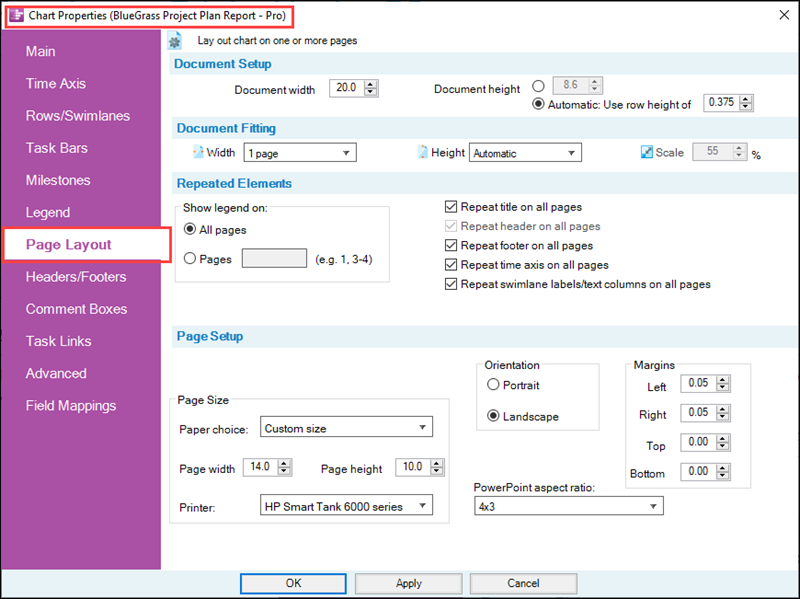
Document Setup
These two settings (e.g., Document width and Document height) determine the document’s size in inches or centimeters irrespective of page count. The overall document size consists of the graph area plus all Adornment areas (i.e., header, footer, time axis area(s), title, text columns, swimlane labels, margins).
Document width is always automatic in that OnePager makes no attempt to keep the width constant as you change swimlane label widths, text column widths, or horizontal margins. Because the number of rows/swimlanes is very dynamic, there are two modes for managing document height.
Automatic height mode
When the Automatic: Use row height of: radio button is clicked, the document height adjusts when rows/swimlanes are added/hidden. Likewise the document height adjusts if you change the title height, time-axis height(s), header/footer heights, or vertical margins. This mode is the preferred option because it preserves the heights of task bars and milestones symbols.
Fixed height mode
When the Document Height radio button is clicked, the document height is kept constant in the following situations:
- 1) Creation of the chart from a Template Properties form.
- 2) Update of the chart by adding or replacing snapshots.
- 3) Automatic hiding of blank rows using the Crop button on the ribbon.
- 4) Change of parameters on the Row/Swimlanes tab of the Chart Properties form.
In all these situations, the document height is kept constant by adjusting the heights of all the rows and swimlanes to take up the slack. This behavior has the disadvantage that adding many new rows causes task bars/milestone symbols to get very short and hiding many rows causes task bars/milestone symbols to get very tall. Even in this fixed height mode, manual insertion/hiding of rows/swimlanes, changes to header heights, changes to title height, and changes to time axis heights alters the document height. To preserve the heights of all the tasks and milestones in the graph area, you can always restore the old document height by entering it in the document-height numerical window control.
Document Fitting
The document fitting group determines the number of pages vertically and horizontally.
For more specific information on Document Fitting, Document Fitting, Page Setup, and Repeating Elements, please see the articles at:
| Document Fitting |
| Creating Multi-Page Charts (Portal) |
Repeated Elements
The repeated elements group has two sets of controls:
- 1) For repeating the Legend on multiple pages and
- 2) For controlling the repetition of other Adornments on multiple pages.
For more specific information on Repeat Elements, repeating the Legend on multiple-page and for the controls for repeating view Adornments, please see the articles at:
| Repeating Elements |
| Editing with the Chart Properties form (Portal) |
The controls discussed above are also available on the OnePager Page Layout ribbon tool bar tab.
Page Setup Control Group
The page setup sub-group contains controls for:
- 1) Specifying physical page size of output,
- 2) Setting the output page’s orientation (portrait or landscape), and
- 3) Establishing the physical page’s margins.
Page Size Sub-Group
The page size sub-group has the following three (3) controls:
- 1) Paper choice. This list is built from the available choices associated with the printer selected. See below.
- 2) Page width and height. Displays the dimensions of the current page size selection and lets you specify custom page dimensions.
- 3) Printer. Contains a list of printers known to Microsoft Windows.
Orientation Sub-Group
The orientation sub group has two radio buttons which you can use to select the orientation of the output page as either portrait or landscape.
Margin Sub-Group
The margin sub-group provides four window controls for you to set the left, right, top, and bottom margins in inches or centimeters.
PowerPoint Aspect Ratio
Microsoft PowerPoint accepts imported images in 4x3 and/or 16x9 aspect ratios depending on the version of Microsoft PowerPoint being used. OnePager supports exporting images in both aspect ratios. The PowerPoint Aspect Ratio dropdown provides two (2) aspect ratio choices for you to use when exporting charts to Microsoft PowerPoint as shown below:
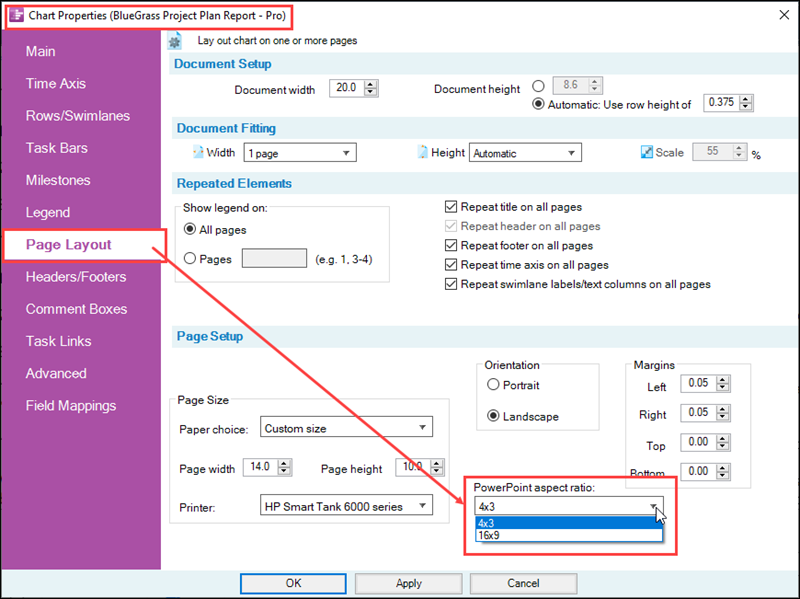
Assuming a OnePager chart that looks like the chart shown below, you have the option to create a Microsoft PowerPoint export file that produces the same chart but with different aspect ratios when imported to Microsoft PowerPoint. The OnePager chart for this example is shown below:
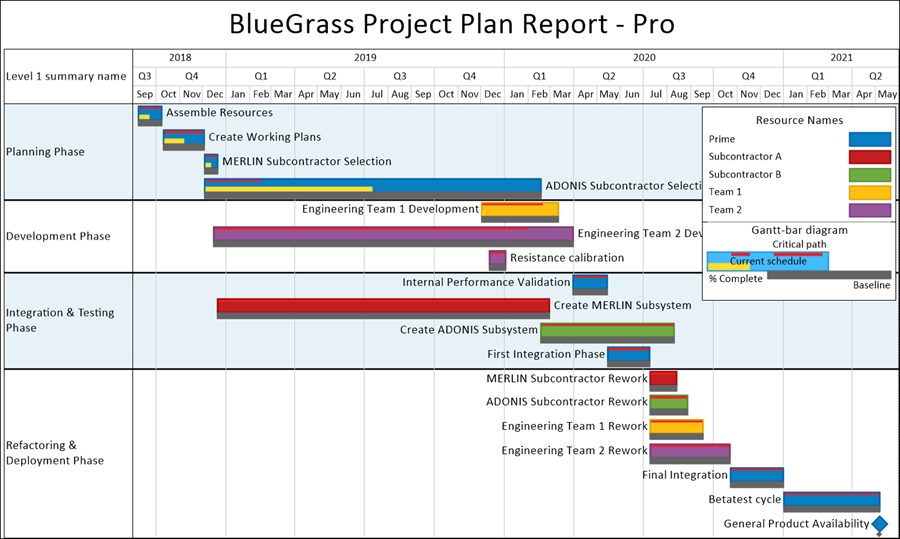
If the above chart is exported to Microsoft PowerPoint using the 4x3 aspect ratio, when the chart is imported to Microsoft PowerPoint, it looks like this:
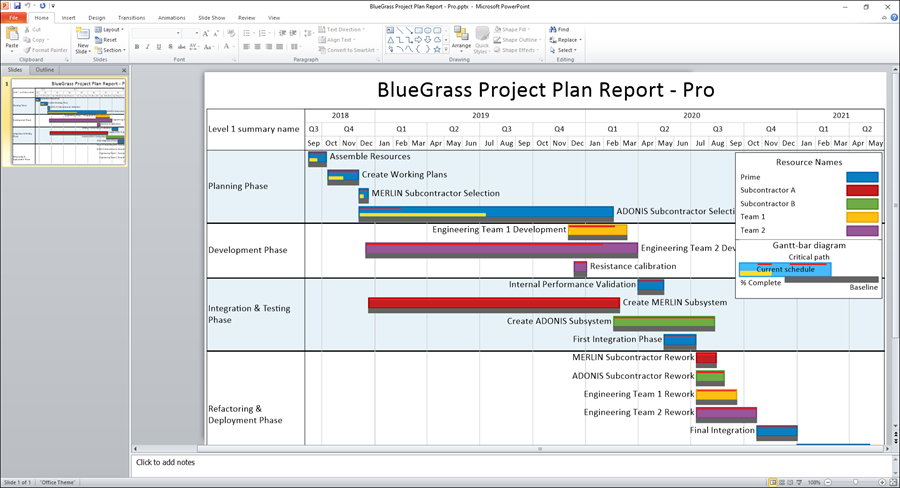
If the above chart is exported to Microsoft PowerPoint using the 16x9 aspect ratio, when the chart is imported to Microsoft PowerPoint, it looks like this:
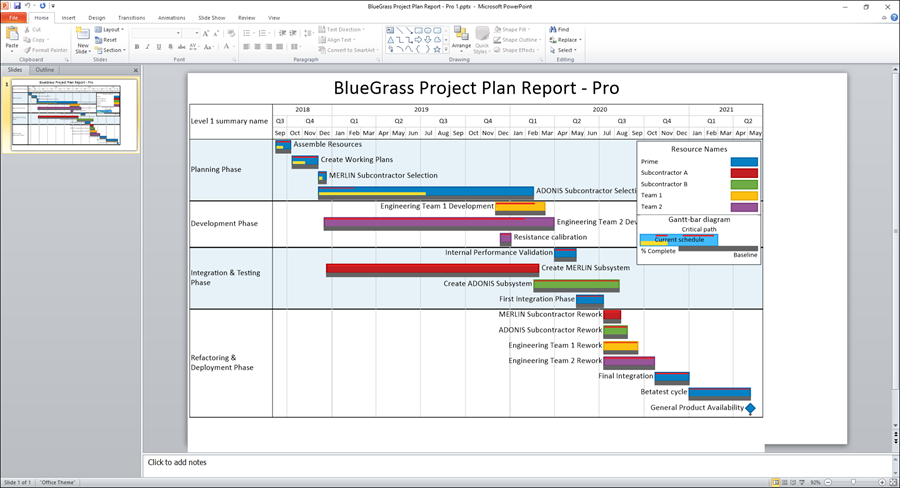
The default setting in OnePager distributed Template Properties forms is 4x3.
For more information on exporting charts to Microsoft PowerPoint, please see the article at this link:
| Sharing via Other Applications (e.g., PowerPoint) |
When controls in the Page Setup control group of the Page Layout ribbon tool bar tab are changed, OnePager updates the corresponding controls in the Print form accessed through the File ribbon tool bar tab. These controls are available on the OnePager File ribbon tool bar tab by first clicking the page’s Print tab button and then the Settings button which accesses the Chart Properties form’s Page Layout tab.
The steps and results are shown below:
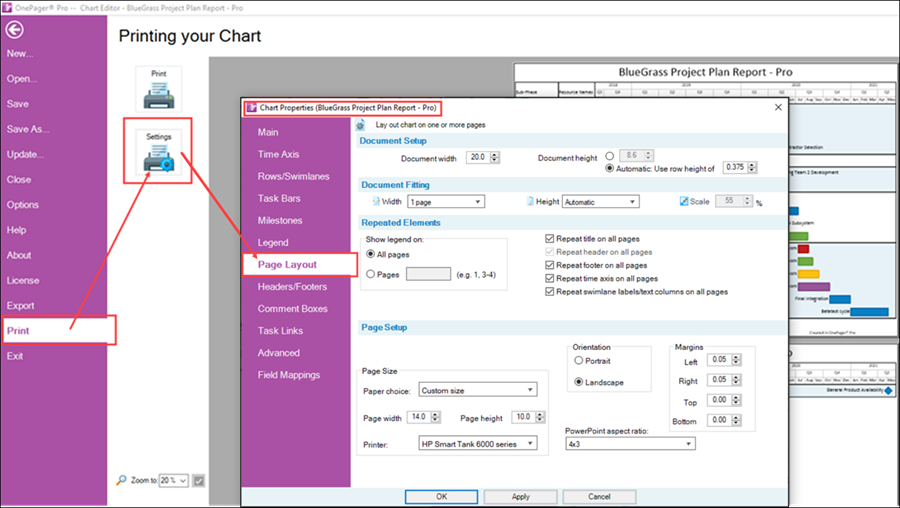
For more specific information on Page setup, please see the article at:
| Page Setup |
Related Links
(21.8.1-72)